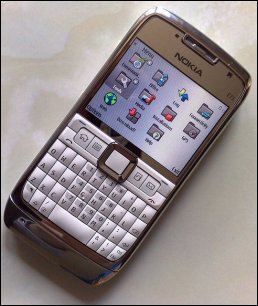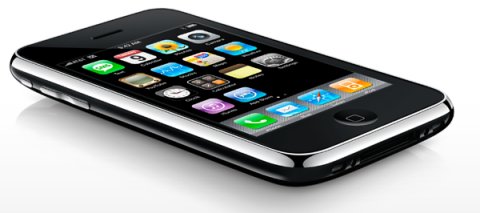Nokia’s announcement yesterday of the E71 and E65 continued the progression of the Finnish company tailoring the feature set of their devices to specific market segments. Alongside the broad strokes of the Eseries (Enterprise) and Nseries (Multimedia) labels, the individual models are becoming more and more separated, especially in the Eseries range. Given the timing of the announcements, it’s also natural (if a bit fortuitous) for people to compare these devices to the iPhone 3G announced last week; more so given the enterprise features added to Apple’s second mobile phone.
 Steve’s already pointed out in his E71 review that the iPhone and the E71 in terms of physical dimensions are roughly identical, yet their functionality, and how they use the space is radically different – the input mechanism choice of either keyboard or multi-touch screen being the most obvious. And I’m of the opinion that this diversity in choice is good for the market. It’s good for every market – you’ve got multiple models of cars from auto manufacturers, different laptops from companies like Dell, different sizes and styles of books from publishers… variety is a sign of strength, not weakness. The inevitable ‘why can’t we have everything?’ posts on newsgroups didn’t take long in coming, and frankly I think they’re missing the point, both on a commercial point of view, and interestingly, also on an environmental point.
Steve’s already pointed out in his E71 review that the iPhone and the E71 in terms of physical dimensions are roughly identical, yet their functionality, and how they use the space is radically different – the input mechanism choice of either keyboard or multi-touch screen being the most obvious. And I’m of the opinion that this diversity in choice is good for the market. It’s good for every market – you’ve got multiple models of cars from auto manufacturers, different laptops from companies like Dell, different sizes and styles of books from publishers… variety is a sign of strength, not weakness. The inevitable ‘why can’t we have everything?’ posts on newsgroups didn’t take long in coming, and frankly I think they’re missing the point, both on a commercial point of view, and interestingly, also on an environmental point.
I don’t think we’ll ever see a mass-market smart phone that has every potential feature crammed into an affordable device. Something will always be lacking. There will always be a missing feature that stops you moving from your current (but older) perfect phone to the next model. That’s because that model is, in all likelihood, not aimed at you, but there’s enough commonality in the design and base functions to make it attractive to any 'smart phone user' (sic). The constant need to have the latest model is blinding some to the benefits of the model you have, not the model the press says you should have.
The one phone that is perceived by many to (be about to) do everything, the iPhone 3G, has its own discrepancies to some, notably in the poor camera and mysterious lack of video capture. It’s also worth remembering that while the iPhone might be just one device that [allegedly] does everything for its users, the user-base of the iPhone is probably equivalent to the user base of just one Nokia S60 device. The problem, at least for the analysts, is that there is no direct equivalent device out there for the iPhone – in the same way that there is no direct equivalent of an N95, E71, Blackberry or Palm Treo.
All the models excel at different things, they are all geared towards a slightly different segment of the market, and I suspect the addressable user base (as opposed to the actual installed base) of each device will be roughly similar. The fact that these user bases have significant crossover is a testament to just how flexible and customizable the current crop of smartphones is.

The argument of whether it is correct to build one device where each user only utilizes (perhaps a different) 65% of the capability of the device, or to build a number of devices where the users will use 95% of a smaller feature set has an obvious answer. Unfortunately the obvious answer is a different answer depending on your view. Power users want everything, every last drop of performance and feature, even if they’re only going to use it for five minutes every year. But manufacturers presented with the bill of materials for the handset know that knocking out the infrequently used areas can massively reduce the unit cost of the device; and therefore provide a better balance of lower priced phones and profit to the company.
Until users start building their own phones, the targeting of devices with a perceived subset of features will continue.
And long may it continue – partly because it’s nice to have a phone where you do use everything, partly because carrying too many features (the 65% scenario above) is just wasteful on your memory, storage or battery, and partly because in the current climate, we shouldn’t be wasting the Earth’s resources building tens of millions of extra accelerometer circuits in order to force them onto every mobile phone user - just in case.
-- Ewan Spence, June 2008
